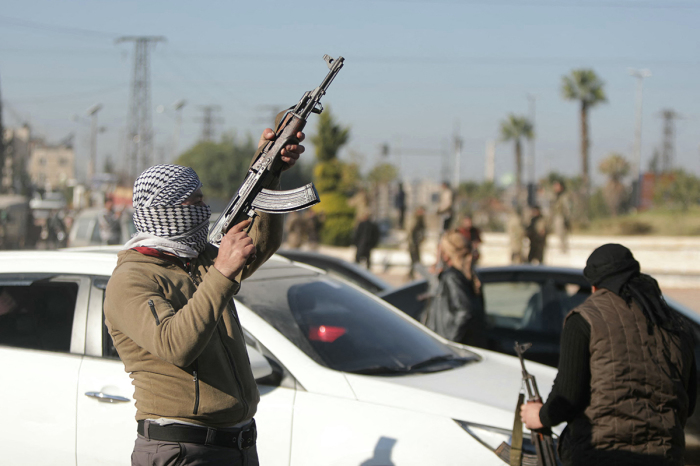
The Islamic State has claimed responsibility for its first attack targeting Syria’s transitional government, saying it killed or injured seven members of what it described as the “apostate Syrian regime.”
The terror group, also known as ISIS or ISIL, claimed it carried out two attacks on a military road in the desert region of Talul al Safa in the southern province of Suwayda on May 22 and May 28.
In one attack, on May 22, a blast in the desert region killed or wounded seven Syrian soldiers, IS said in a statement, according to The Associated Press.
Militants also ambushed a reconnaissance unit from the Free Syrian Army that was monitoring IS, leaving one killed and three injured, a military source told CNN, adding that the terrain in the area is often exploited for cover by IS because of its rugged terrain.
SITE Intelligence Group, which monitors Islamic extremist activity online, said IS posted two separate statements claiming responsibility for the incidents, claiming that bombs planted by IS fighters killed and wounded members of the Syrian military and allied militias.
IS has maintained cells in southern Syria despite having been largely absent from the area for two years, according to the Institute for the Study of War, based in Washington, D.C.
The terror group previously maintained control of large territories in Syria and Iraq but was territorially defeated by U.S.-backed forces in 2017. Since then, it has operated as an underground insurgency, particularly in Syria’s central desert and eastern provinces.
The attacks are the first directly claimed by IS since the installation of Syria’s transitional government under former jihadist Ahmed al-Sharaa in December. The new government emerged after the collapse of Bashar al-Assad’s regime, and it has faced criticism for failing to restore order in key parts of the country, including Suwayda.
The United States and other Western governments have urged the new Syrian administration to prevent the resurgence of extremist groups. However, efforts to assert control in certain areas have faltered.
Before these attacks, IS had only targeted the Kurdish-led Syrian Democratic Forces since December, reports BBC jihadist specialist Mina Al-Lami.
“IS attributed these [recent] attacks to its so-called Houran sub-branch in Syria, which had not claimed any attacks since 2023,” Al-Lami posted on social media.
Suwayda, primarily populated by the Druze minority, remains unstable due to ongoing sectarian clashes. Over 100 were killed in violent confrontations between local militants and pro-government forces in the province during late April and early May. Hundreds died in clashes that erupted in early March along Syria’s Mediterranean coast, in Latakia and Tartous.
The Syrian government has not officially acknowledged any IS attacks in Suwayda. It did, however, report two raids against IS operatives in the Damascus area last week.
The attacks come amid deepening instability across Syria. Syrians continue to face a deteriorating security situation, with frequent kidnappings, thefts and reprisals in both urban and rural areas.
A recent report from a Syrian Christian, whose name was withheld for security reasons, described the new government’s focus as being more on “whitewashing its brutal history” than addressing domestic insecurity, according to Christian Daily International.
The report noted a worsening humanitarian situation, including electricity cuts — down to as little as two hours per day in some areas — and water shortages. Infrastructure remained crumbling, and the country’s healthcare system was under strain due to staffing cuts reportedly based on ethnic and religious identity.
Before leaving office in January, former U.S. Secretary of Defense Lloyd Austin stated that U.S. troops should stay in Syria to prevent IS from regaining a foothold and feared that pulling out prematurely could allow the terror group to grow back into a significant threat to global security. Under President Donald Trump, the U.S. has begun pulling troops out of Syria.
The U.S. also shuttered small operating bases in Syria’s northeast, reducing troop levels to about 1,400 from 2,000, senior officials told The New York Times in April, adding that a reassessment will be done after two months. A source said that commanders have urged the administration to keep at least 500 troops in Syria.
Last December, the Department of Defense announced that there were 2,000 U.S. troops deployed in Syria, which is more than double the 900 that had been reported in the past.
Pentagon officials said in April that the U.S. would consolidate its forces and reduce the troop total to under 1,000 in Syria in the coming months.
“Recognizing the success the United States has had against ISIS, including its 2019 territorial defeat under President Trump, today the Secretary of Defense directed the consolidation of U.S. forces in Syria under Combined Joint Task Force — Operation Inherent Resolve to select locations in Syria,” Pentagon spokesman Sean Parnell said in a statement. “This consolidation reflects the significant steps we have made toward degrading ISIS’ appeal and operational capability regionally and globally.”

















